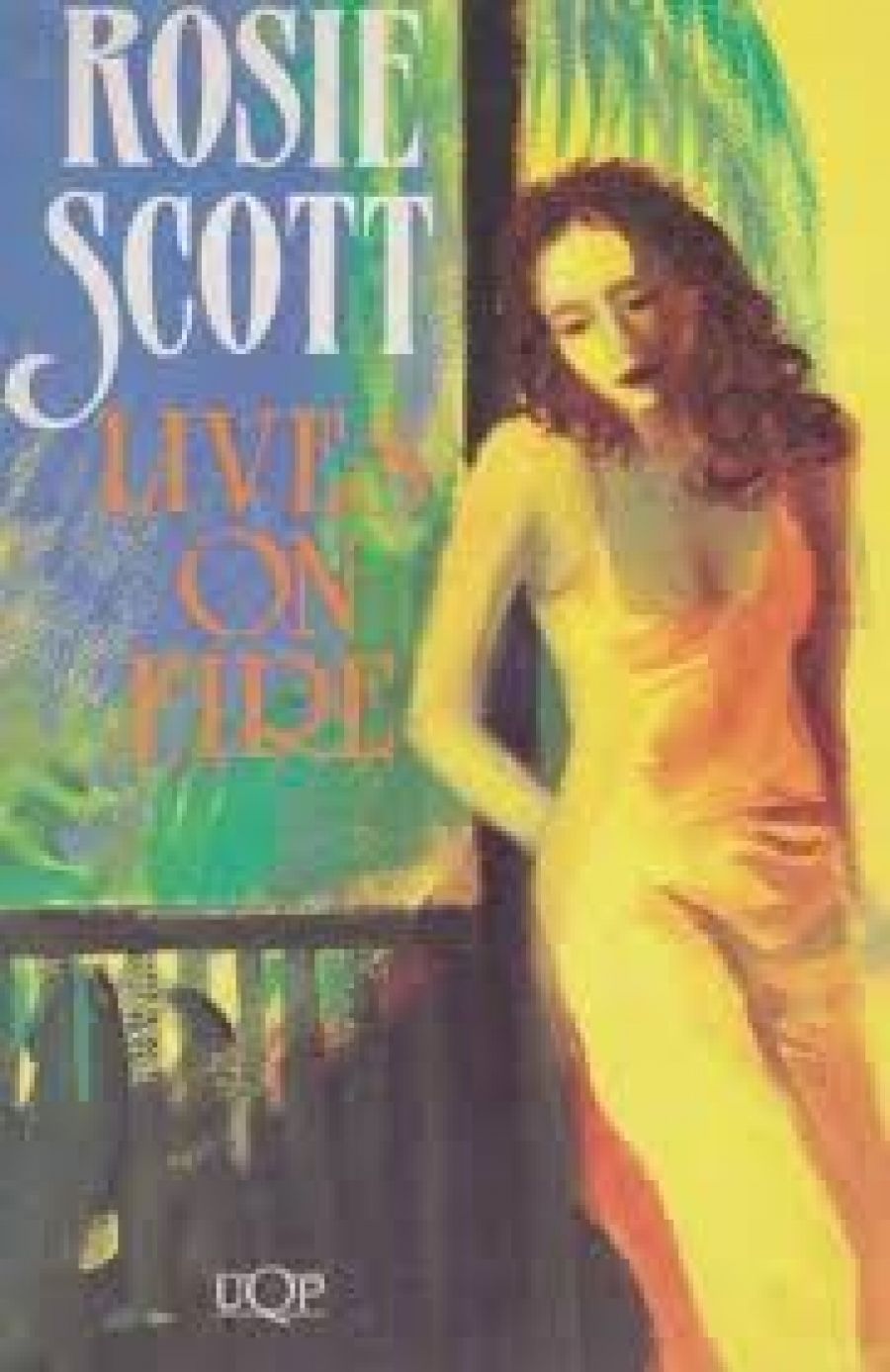
- Free Article: No
- Contents Category: Fiction
- Review Article: Yes
- Online Only: No
- Custom Highlight Text:
Connoisseurs of lapidary prose and the fine art of understated narrative are unlikely to enjoy this risky passionate novel. Nor will they enthuse over sentences such as, ‘The agony was so extreme I was numb with it, as if I had fallen into a vat of molten steel and could not immediately feel the enormity of the burn’, or, ‘Flooded with embarrassment, desire, delight, I thought stupidly, no wonder men go so wild over women, no wonder they dream continually of being lapped in that heavenly softness as they go about the hard world.’ However, Rosie Scott has made her own priorities clear in a 1991 essay called ‘Come and see the blood in the streets’.
- Book 1 Title: Lives on Fire
- Book 1 Biblio: UQP, $14.95 pb
Lives on Fire follows a fairly simple storyline. Belle has gone to Brisbane with her husband, Tyler. Away from their Sydney home, children, and her life as an actress in television and film, Belle finds herself taking stock of family life. A beautiful young actress with whom Belle once worked, called Sky, invites herself to stay and Tyler falls in love with her. While Tyler and Sky begin a new life together, Belle builds new bridges with her children and an agent-mentor figure called Nick. She has been spending time doing improvisations with street kids in Brisbane and having done her own private foray outback, she sets out with a small band of them in a van to tour as a troupe.
The narrative feelingly documents the plight of street kids and discrimination against Aborigines; and it goes beyond to question the social and cultural values that bolster these things. There is a wonderful account – or is it diatribe – by Belle on the insidious power of the American soap:
Well-nourished, vapidly beautiful, utterly self-absorbed, the actors walked about the coldly luxurious sets as if they were automatons. I watched in fascination as they mouthed the lifeless words in frame after frame. It was really like some kind of special American hell, a ring of fire, the terror of the undead reflected in their blank perfect eyes, their surroundings, where even the flowers in bowls were as flawless as plastic, the weather-beaten old world outside choked off forever. I had never watched the show before and now I wanted to watch them talking forever, especially after my third gin.
The passage almost literally constitutes a hell-fire sermon on the power of the cultural artefact to stereotype and marginalise; and it is sharply contrasted with unsentimental descriptions of tough yet vulnerable street kids who have been marginalised and who finally present Belle with her best opportunity to find ‘salvation’ from the plight she finds herself in.
Rosie Scott has also expressed a concern with ‘Finding the Language for Sexual Ecstasy’ (the title of an essay published in 1992) and Lives on Fire contains many descriptions of Belle’s sexual feelings towards her husband before he falls in love with the other woman and afterwards: smells, sounds, little jealousies, larger jealousies. When these passages work from sensuous detail they are passionate and full of energy. At other times, though, the language can fall into cliché or generality:
Sky called something from the bedroom and when [Tyler] turned to answer her it was as if his face had melted with love, his mouth trembling with apprehension and joy, his eyes so soft in the darkness. I felt my insides contracting with agony. Beyond him in the bedroom her soft form, her face were in deep shadow.
In addition, the feelings of Belle dominate the novel at the cost of others in it. Lives on Fire is Belle’s story but by the end I felt I had been buttonholed by her. I wanted to hear something about her husband’s relationship with their children (a curious dead spot in the novel’s account of a family that for years was supposedly a close-knit unit), about the witch/whore/starlette Sky, even about the figure of ‘George the Horse’ who turns up inconclusively in the closing pages with his mystical serenity and computerised caravan. The street kids on the other hand are perfectly judged. The little we know about them is always enough.
Lives on Fire has many memorable descriptions of place and event. Belle’s Brisbane is sweaty, sexy, almost putrid. One of the best scenes is where she narrowly avoids throwing up in an expensive restaurant in the city. Sydney, particularly the stage and film Sydney of her friend, Nick, is flip, malicious, and very entertaining. Outback is bull-barred LandCruisers, shot-up road signs, and white superiority. Belle’s dog ‘becomes more and more feral’ as they head inland. There are many feral things in this novel. Belle belongs to a ‘feral family’, Nick tells her towards the end that she is becoming feral, she goes back to an ‘old dream of a feral theatre’. ‘Dream’ and ‘luminescence’ are very much overused as well.
Rosie Scott has an ambitious agenda as far as the novel form is concerned. Sometimes this drives Lives on Fire to passages full of strength and sympathy. At other times it leads to language which is strained past breaking point. It was the quieter moments in the novel that held me: ‘Here all was softness, and in my drunkenness I felt like a nightwatcher perched high above the treetops, keeping guard on an ancient comely town’, or ‘There I was on one of those old shady Queenslander verandahs, a lemon drink in one hand, shifting my sweaty thighs on the canvas chair, sighing, staring out into the green heart of an umbrella tree as if I’d been rotting there for years’. I can read sentences like these till the cows come home.


Comments powered by CComment